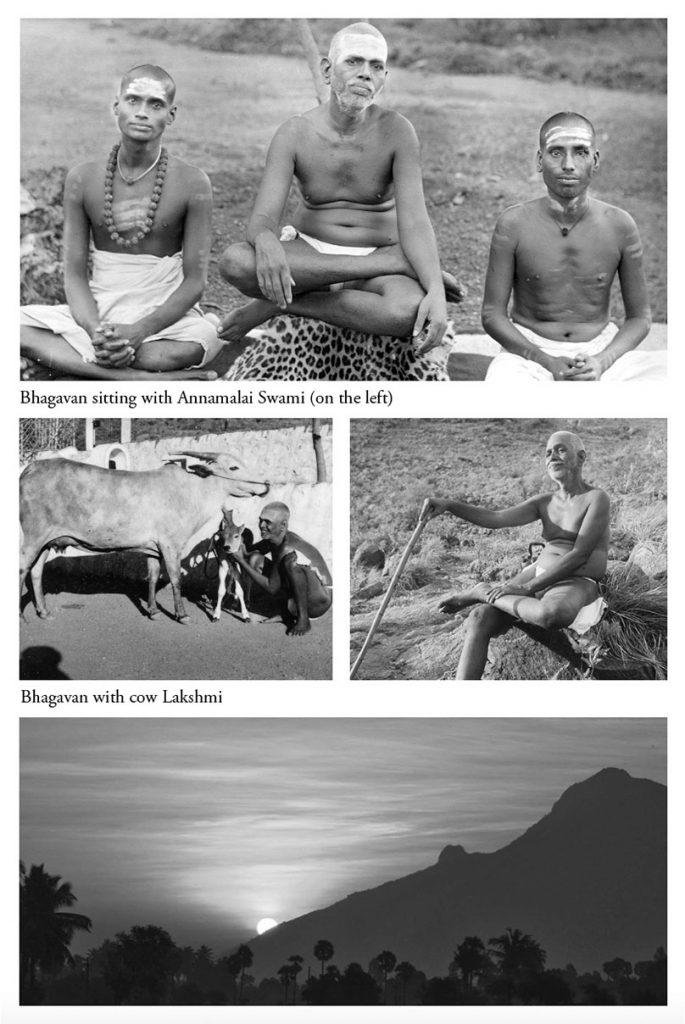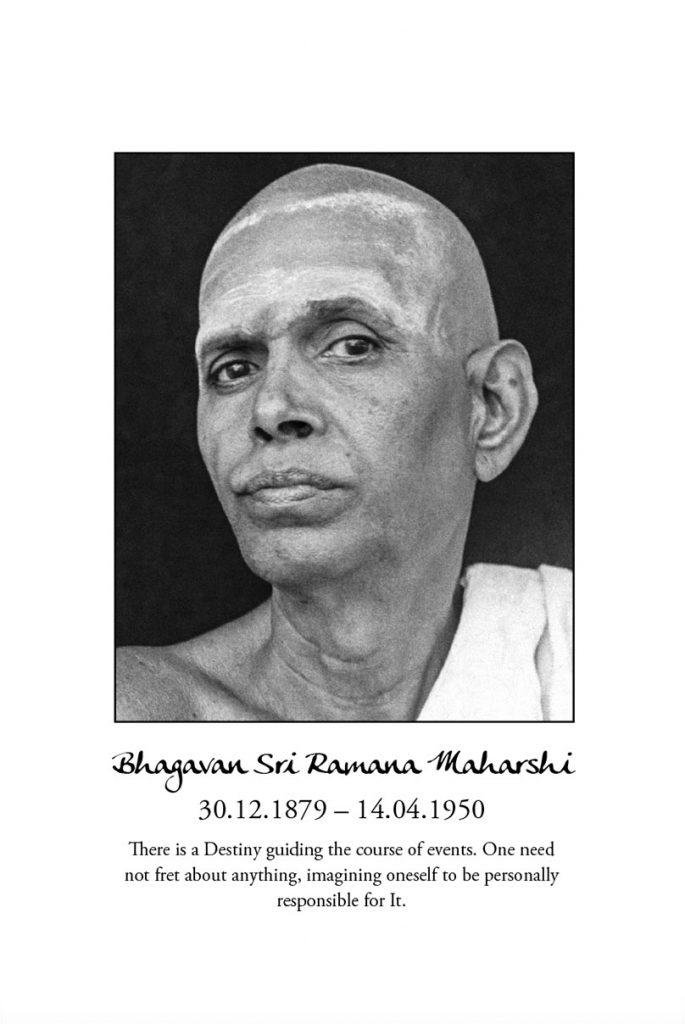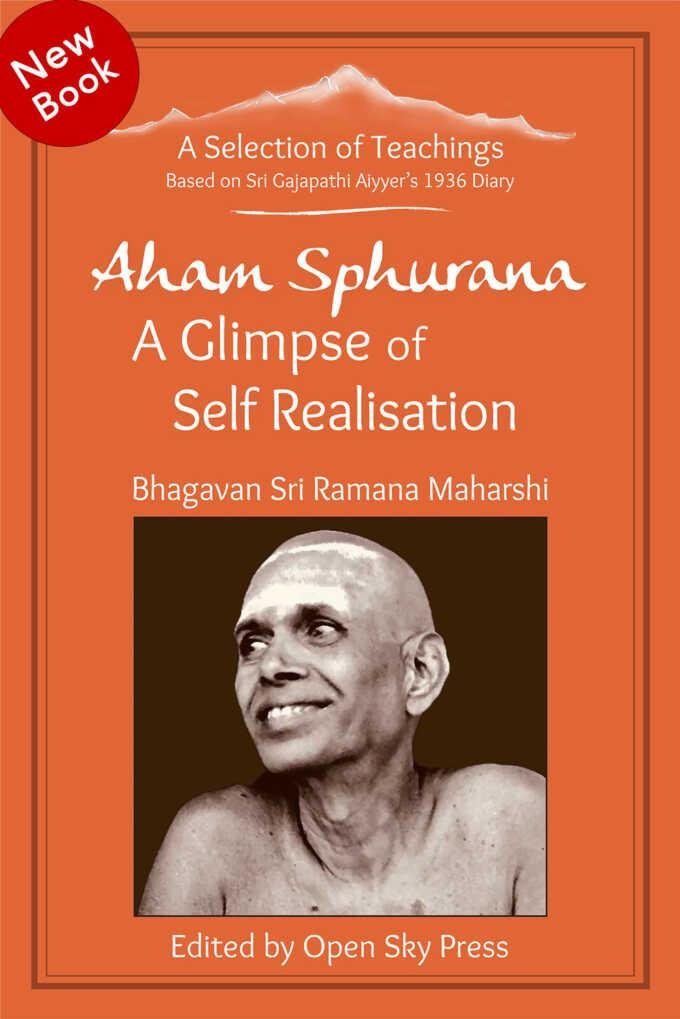Essential Extracts from the Manuscript
Q: So, is this state of consciousness steadily remaining merely as Itself, undisturbed by thought, called the Sahajastithi [the natural state of a jnani]?
B: No. It is called Aham Sphurana.
Q: Then what is the Sahajastithi?
B: No description is possible. The reflected being – consciousness which is localised in a physical body – is destroyed; after this is destroyed, that alone remains which has always been. It is the Absolute Reality. It transcends dualities such as being and non-being, knowledge and ignorance, light and darkness, et cetera. It is THAT – WHICH – IS, that is all that can be said of it. That is what YAHWEH stands for in the Bible. Although there he seems to be a personal God, guiding the destiny of the children of Israel, the Talmudic Prophets of Old knew the transcendental aspect, as did the Christ. God told Moses, “I appeared to Abraham, to Isaac, and to Jacob as God Almighty, but by My name, Yahweh, I was not known to them.” On the other hand, the term Yahweh occurs many times in Genesis. Is there a contradiction? No. Prophets before the time of Moses had known the personal God Yahweh, but Moses was the first to whom the transcendental, formless aspect was revealed. The earlier prophets knew the name but not its significance. They loved God and cherished his name but did not understand the meaning or import of the name.
The name means ‘I am that I am’. God revealed the meaning of the name to Moses, whereas the earlier prophets had only been given the name. The name means that one who is simply subjectively aware, without knowing any object, is absorbed or transformed into God. This is not an intellectual conviction or mental assertion. It is the blossoming of the heart-lotus [hridayapundarikam] of love from within.
Q: Bhagavan mentioned something known as the ‘Aham Sphurana’ yesterday. Having reached this Aham Sphurana, how does one proceed from there to Self-realisation of the final Sahajastithi?
B: Having reached Aham Sphurana, no further effort is possible. For one who has reached the Sphurana [pulsation], this question is impossible – as is any other question. No doubts arise because the doubter has long ago given himself up to the infinite Beingness that shines in his own Heart as the light of the true ‘I’. One who has reached Sphurana and remains perpetually merged in it instead of being unsettled would never think, ‘I have reached the Aham Sphurana. Now I wonder when Realisation of the Absolute Self is going to dawn on me.’ Nor would he think any other thought.
The thinker gone, who is left to manufacture thoughts? The one who steadfastly remains in the Sphurana state does not crave Realisation – nor anything else – for he no more has any needs. Since a fall from it is always theoretically possible, the Sphurana is still classified as sadhana [spiritual practice] – however, it is the loftiest stage of sadhana for it is sustained without the least trace of effort or sankalpa [will] to remain in it.
Continuous Sphurana is possible only after the ego-sense has been finally given up. Before it manifests continuously it is possible for the sadhaka [spiritual seeker] to experience flashes of it. Instead of permitting these flashes to distract him, and instead of making deliberate effort to perpetuate it or voluntarily bring it about again, he should calmly enquire, ‘Who has experienced this?’ until the Sphurana becomes continuous. Once the Sphurana becomes the permanent state, it is also, in due course, extinguished, like the combustion of a block of camphor is complete when neither camphor nor flame is seen anymore, and only Reality remains – that is the Sahajastithi [natural state] of the jnanasiddha [the one who has accomplished true knowledge] about which you are asking.
Q: What are the physical symptoms of the Sphurana? Does it involve loss of functioning of the sensory organs? Does it cause loss of body consciousness?
B: There may or may not be an involuntary spate of isolated breath retention; there would also be a throbbing or pulsating sensation – but why are you asking this question? Dive within and SEE for yourself. The important thing is that in the state of Sphurana there is no such thing as ‘making a decision’. Everything is decided by the Higher Power…and your mind, having lost the ability to measure variety or make value judgements, stands reduced to mere consciousness of being. Sensory organs function normally, and the alienation of body consciousness is yet to be complete, but the events of the outer world are merely witnessed detachedly without any aversion or fascination, as one watching a cinema picture without the slightest interest. Actions are not pre-meditated but spontaneous.
The body becomes a tool in the hands of the Almighty, ecstasy floods the soul, and blinded by the spell of divine intoxication, one weeps and laughs, sings and shouts, without apparent purpose. These are only visible, external symptoms of the Deep pulling within, and may not manifest in all. I was like that in Madurai, shedding tears of longing at the Meenakshi Temple, without having the slightest clue why. Even the thought, ‘Why are we crying?’ did not occur. Not all may obtain the experience of weeping for God, not knowing whether they are weeping in the anguish of yearning or in the ecstasy of fulfilment, and not caring. The important thing is whether inwardly the dehatmabuddhi [the intellect that causes one to identify the Self with the body] or kartritvabuddhi [I-am-the-doer-idea] has been broken or not. If the ‘I am the body-mind complex’ idea is completely abandoned, not a trace of sankalpa or volition remains. Bhagavan did not decide, ‘Let us go to Arunachala.’ Rather, (Gajapathi watched the figure on the Sofa gently touch his right shoulder with one delicate finger) – come here – that is all.
Q: And how to recognise the Aham Sphurana when it ‘flashes forth’?
B: There is no possibility of mistaking it when the experience actually occurs. Whatever description is given is not only useless but also counter-productive, because if a description of the experience of Aham Sphurana is given, the mind twists and contorts the present banal experience of outward-protruding, satiation-craving mental impulses into one that seems to perfectly match with the description given: because it wants to avoid getting destroyed. So, even if you have heard a description of the experience of the Aham Sphurana being furnished in this Hall, please make no effort to recollect it.
When the Aham Sphurana actually flashes forth, you will know it alright. Recognition of the Aham Sphurana is not based on intellectual corroboration – it is a direct experience of the Self, inferior only to the Sahajastithi of the jnani.
Q: In Sat Darshana Bhashya and Talks with Maharshi (1932), it is said as follows:-
Realisation of jnana is always a vritti. There is a distinction between jnana [mental modifications, knowledge] or Realisation and swaroopa [essence] the real. Swaroopa is jnana itself, it is consciousness. Swaroopa is sat chit, which is infinite. It is always there self-attained. When you realise it, the Realisation is called truly jnana. It is only with reference to your Existence that you talk of Realisation or jnana. Therefore, when we talk of jnana, we always mean vritti jnana and not the swaroopa jnana [knowledge of the essence]; for swaroopa itself is jnana consciousness always.
I find this passage completely baffling. Would Bhagavan please explain it to me?
B: When the mind ceases to take any interest in the objective world and remains effortlessly abiding in its native, primeval state of pure beingness, it is vrittijnanam [turning the mind inwards]. One may be said to have reached the state of vrittijnanam only if and when his mind remains so not as the result of any motive or objective but because of the fact that now it does not know anything else. The mind, which was earlier consciousness concealed by a labyrinthine network of vrittis [mental habits], is now reduced into simple consciousness of being to which effort or objective is altogether alien. Then there is no question of straining oneself to remain still.
Stillness is now the natural state. This is manonivritti [freedom of mind structures] or vrittijnanam. In this state there is nothing available to deflect one’s attention away from subjective awareness. The mind remains transfixed at the point of its origin. The light of ‘I’-‘I’ can be clearly felt to be shining. The experience of the scintillation ‘I’-‘I’ is called Aham Sphurana. Since this state is not brought about by means of expenditure of any mental effort, but rather on account of subsidence of mind, some books say that it is a transcendental state.
Q: Is that the state of the jnani?
B: No. When even the rarefied mind is destroyed in the Beyond, it is the Sahajastithi [full knowledge of the Self] of the jnani. But you need not worry about all this. It is unnecessary. It is enough to lose the ego. Thereafter everything is automatic.
B: This phenomenon is called Aham Sphurana or ‘I’-scintillation. It indicates that a state of incomplete or partial absorption in the Heart was prevailing at the time when such scintillation took place. Complete absorption is the desirable state.
Q: How can I bring about such complete absorption?
B: Your efforts can extend only as far as the Sphurana [pulsation]. Abide continuously and incessantly in the Sphurana; leave the rest to God or Self.
Q: Often, even whilst the Sphurana is going on, thoughts appear and distract me. What should I do at such moments?
B: Gently extricate yourself from the thought; that is all. The mental faculty is not destroyed whilst the state of Sphurana is in operation; it is in a state of suppression; whenever it reasserts itself, look closely at the thought that caused such re-emergence and it will vanish. Steady, continuous practice is required until you have naturally become established in the Sphurana – that is, until you reach a state wherein no effort on your part is necessary any longer to keep up the Sphurana.
Plunge the mind in the Sphurana again and again and again and keep it submerged there until you find that the Sphurana is going on naturally and without any effort on your part. If there is a desire or resolve within the mind – ‘I am carrying on with the Sphurana because doing so will earn me Liberation’ – Liberation will never dawn. The Sphurana should not be the result of any mental process; it should be natural, motiveless, spontaneous and uncaused by anything. Only then will Liberation dawn. Those who expect or anticipate or want Liberation never find it. Abandon yourself to the Sphurana unconditionally and it will Liberate you.
Q: What is the difference between the state of Nirvikalpa Samadhi [mind dissolved only Consciousness remains] and that of Aham Sphurana [a glimpse of Self-realisation] – if any? Which is the superior state amongst these two, and which is the supreme state?
B: Both are equally worthy. In Nirvikalpa Samadhi, body-consciousness might be absent. Nirvikalpa + body-consciousness = Aham Sphurana. However, Aham Sphurana is conducive for destruction of vasanas, whereas the same is not possible when the mind is temporarily sucked into the Heart, shutting out body-consciousness and precluding the possibility of sensory perception for the duration of the experience (of Samadhi).
Q: Yogis are said to divest themselves of body-consciousness and remain in its absence for decades together.
B: Yogis try to eliminate body-consciousness by practising Kevala Kumbhaka [breath retention] for abnormally large spans of time – but the trouble with adopting such an approach is that the volition or intent to remain bereft of body-consciousness remains still to be tackled. For this reason, it is better to not try to forcibly eradicate body-consciousness, which, after all, is only a harmless upadhi [limitation] once you have given up the notorious, delusory habit of false identification (of the Self with the not Self).
All possibility of volition and effort must be destroyed before jnana can dawn. As per the body’s prarabdha, let the upadhi of body-consciousness drop off automatically. We need not bother about it, regarding it as any hindrance to be resolved or tackled. You need not try to destroy the body or somehow reduce it into nothingness. Simply cease to identify or associate with it in any manner; that will do. Trying to get rid of the body implies paying further attention to the body. Instead, channel attention away from the body and into the Self; that is the thing to be done. As for the supreme spiritual state, which you asked about, it is the Sahajastithi of the jnani. It cannot be attained by sadhana. No effort can reach it. Surrender yourself to it unconditionally and you will be absorbed into it. Vichara [Self-enquiry] is only to prepare the mind for unconditional surrender. If you can surrender absolutely, where is the need for vichara and where is the possibility – who would then be left to investigate?
Q: Is the Self located on the right-hand side of the chest?
B: Only up until it is necessary for you to admit that you have a body. Do you?
Q: Yes. How can I deny it? Does not Bhagavan see this body talking to him?
B: The body does not say ‘I am you.’ You say that you are it. When you have weaned yourself away from this erroneous attitude that you are somehow linked with the body, then you will know where the Self is. The Self is not anywhere; it IS.
Q: What about Sri Bhagavan’s idea that the hridayagranthi [the knot of the heart] is represented by a physical spot in the body – if the Self is inherent only, doesn’t this idea become invalid?
B: Discover the non-dual Self and we can worry about its relation to the body later if need be: then, not now. It is true that there is an opening on the right-hand side of the chest, fashioned like a tiny hole. This contraption remains always closed, but it is opened by vichara – the consequence is that Aham Sphurana shines forth. However, all this is only from a relative point of view. In actual fact, the jnani who abides in the state of ajata Advaita [the Absolute] is quite irrevocably lost to ‘physical reality’. These explanations are not for him; they are formulated only to satisfy the curiosity of ordinary citizens – their truth is only as true as the truth of your own bodily Existence, and no farther.
Q: Will vivisection of the body by a skilled anatomist reveal the presence of this organ?
B: No. It is on the subtle plane.
Q: Well, using a microscope then?
B: I meant to say that in my experience it is purely a locus for accumulation of mental energy. It might not have any physical coefficient. However, a physical sensation of pulsation or throbbing might be felt at the region. The fact is, such matters are not at all important. The thing to do, or rather un-do, is to Realise the Self. Whatever you experience is beside the point. Who is the experiencer? That is the critical question.
Q: Is the Japanese concept of Satori the same as the Hindu concept of Moksha [liberation]?
B: No. Satori is Spandabhraja Samadhi [absorption in bliss] or Aham Sphurana [‘I’-pulsation].
Q: What is this ‘I’-’I’? Is it the same as jnana?
B: No. ‘I’-’I’ is the stage before the Sahajastithi of the jnani. It is known as Aham Sphurana. When the Sphurana becomes continuous, unstoppable, and spontaneous – that is, when it has solidified itself, so to speak, into a permanent phenomenon – it leads to the Sahajastithi [the state of the jnani]. In vedantic parlance Aham Sphurana is known as vrittijnanam. It may otherwise be known as cosmic consciousness. It is called ‘cosmic’ because the mind in that state is in a generic form. That is, it is not held captive by the ahamvritti [‘I’-thought] for the duration of the experience. If the destruction of poorvasamskaras [latent predispositions] is incomplete, afterwards the ahamvritti reasserts itself and the flow of thoughts resumes itself as usual. The Sphurana, when held on to continuously, weakens the ahamvritti which alone is the cause of the hridayagranthi [knot between the sentient and the insentient – that is, the ego] and bestows mukti [freedom from embodiment and future births].
Q: How to hold on to the Sphurana continuously?
B: The effort or will or volition to do it is itself an obstacle to the shining of the Sphurana. If you remain as you ARE, the Sphurana shines forth of its own accord.
Q: Has Bhagavan said that the experience of the Sphurana is accompanied by a prickly sensation on the right-hand side of the chest?
B: Leave alone the physical sensation; it might be brought about by the Sphurana, but it is profitless to think that merely having experienced the sensation means that you have accomplished something. The important thing is to always remain in the state of effortless-and-volitionless thoughtlessness. The subtle ‘I’, which witnesses the fact of the mind remaining in this state, must also vanish. Only then is Realisation made possible.
Q: Sometimes you talk about something called Aham Sphurana. Is this the same as cosmic consciousness?
B: Yes. It is called so because when in that state the subtle mind feels the Heart as a pulsating vibration; the accompanying physical sensation on the right-hand side of the chest may also manifest. But this sensation, on the whole, is not worthy of any deep consideration; it only serves as an indication that the mind, through long practice, has become largely subtle and serene. It is a symptom of progress but should not itself be mistaken to be the goal. The important thing is for the mind to always remain in its native state of effortless-and-volitionless absence of thought.
Q: When I investigate Who am I? I feel an intense, throbbing sensation in the heart-centre, which Sri Bhagavan talks about, on the right-hand side of the chest. It is like a sensation that a person would have who is overwhelmed with emotion; it brings tears to my eyes. Every time I investigate Who am I? I am drawn to this centre. Is it enough to hold on to this sensation? I ask this question because I have heard that it is Bhagavan’s opinion that although concentration on this heart-centre is a beneficial spiritual exercise, it is not the same as vichara; and I do not want to get side-tracked into doing anything that is not explicitly vichara. I am particularly anxious to get emancipated in this birth.
B: Instead of trying to hold on to such sensation, remain unreactive. Why invent a spurious ‘I’ and then ask him to decide whether he wants to hold on to the sensation or not? If you try to hold on to such sensation, it will vanish. Do not try to ‘do’ anything with the Sphurana. If you try to ‘do’ anything with it or catch hold of it, it will vanish and you will be left wondering where you went wrong and why the sensation has vanished. The Sphurana must be continuous. It will remain that way only if you leave it alone – that is, remain as you naturally ARE. Perfect absence of effort is what is needed to sustain the Sphurana continuously.
Why? Because effort implies the existence of the ego making it, and if the ego resumes its activities the Sphurana will have to subside. Make every effort to remain totally without any effort. Who is that one who wants to hold on to the Sphurana? He is the mischievous imp known as the ego. So, do not permit the ego to disturb the Sphurana; let it go on indefinitely by means of exclusively remaining solely as It (the Sphurana) perpetually. This Sphurana is a partial experience of the Self. It is an indication of the coming Glory. But if it is to elevate into the Self it must be left undisturbed; it must be permitted to go on indefinitely. For that, the ego must be kept in check – by means of vichara. So, whenever you find the Sphurana subsiding, ask yourself Who am I? It will come aright in the end.

Photos from the Book


23rd September 1936
A Small Wise Boy
A small Iyyengar boy, whose family has come to visit Sri Bhagavan from the neighbouring village of Nedungunam, and who has accompanied his parents and relatives to the ashram, had brought along a pambaram [spinning top] and was playing with it in the Hall. The attendant felt that it would be a disturbance to those who were meditating in the Hall and tried to seize away the boy’s toy. The boy understood why the attendant was moving towards him and cried out, “I shall not play with it afterwards, but please let it finish spinning of its own accord; pray do not stop it!”
His childish voice rang out with these words in so shrilly earnest a fashion that everybody smiled, including Sri Bhagavan. The boy’s father apologised to the Hall, came forward and grabbed the pambaram off the floor, and thrust it into a pocket of his khadarjibba (cotton shirt).
Then he roughly lifted his son off the floor by the arm and deposited him in his mother’s lap. The boy started whimpering, but was swiftly lulled into sleep by his mother, who rocked him up and down and uttered soothing words in his ear.
The Master cheerfully remarked to the boy’s father, “See, your son has answered your query.”
Q: I don’t understand what Bhagavan is trying to tell me; it is hoped fervently by me that he will kindly pardon my ignorant son for having made a disturbance.
B: Yesterday you asked a question about the jnani’s prarabdha. Do you remember?
Q: Yes; if the jnani has transcended all prarabdha, how come there yet remains a body for him, is my doubt; but Sri Bhagavan silenced me by saying, “Why bother about jnanis? Attend to yourself first and foremost. If the truth about one’s Self is discovered, all doubts stand resolved.”
B: Did you notice what your son said? What was his request? He would stop playing with his pambaram, but the present session of rotation must come to a close naturally. You, of course, paid no attention to his imploration, but stopped the pambaram then and there.
However, Ishwara is not like this. The prarabdha which is attached to the jnani’s body will have to exhaust itself inevitably. It has to be remembered that this explanation does not hold good as far as the jnani is concerned; from his point of view he already has no body at all. It is only the onlooker who thinks that the jnani is the body; the jnani Himself does not make that mistake. The body, being insentient, is not capable of saying, ‘Look here, I am you; you must take good care of me, who am yourself.’ It is you who imagine, ‘I am the body.’ Put an end to such imaginary identification and all will be well.
19th September 1936
Vinayakar Chaturthi Celebrations and Mr Knowles
Today Vinayakar Chaturthi [Celebrating the birthday of Ganesh] celebrations are observed at the ashram. When I entered in the morning, a small motley crowd consisting of yellow, white, and brown faces was standing near Sri Bhagavan’s mother’s Samadhi. A large clay idol of Vinayakar has been installed near the Samadhi.
As I moved closer, I was somewhat astonished to see the Master himself standing in the midst; he did not usually attend the puja [worship ritual] performed every day at the spot of the sarcophagus. Not being interested in the ceremonies of ritualistic worship, I tried to move on towards the Hall as usual and scurried forwards; but a hand caught hold of my right arm: it was Sri Bhagavan himself!
I turned and stood facing him speechless; the exhilarating thrill of the divine touch of his sacred flesh can be known only by those who have experienced it for themselves. The Master’s flesh was soft and loose – almost unwilling to be stuck to the bone; it was tender and cool to the touch.
“Where are you going? Without you, how can we celebrate Vinayakar Chaturthi?” he joked.
The sarvadhikari, who was standing nearby, laughed and said: “Bhagavan refused to allow the puja to be started without you having arrived.”
So I was made to stand near the clay idol. Every time the priests finished one line of their incantation I was asked to throw some flowers upon Vinayakar’s idol. After some time Naivaedya [ritual food offering] was offered to Vinayakar and prasadam [sacred food] distributed.
A widow known as Yechammazl, who is apparently an old devotee of the Master and has been coming to see him every day since the time when Bhagavan used to stay in the Virupaksha cave, has come well before day-break today with a young boy I took to be her grandson, bringing kozhakattais (sweet dumplings) for all to eat. But (incorrectly) assuming her to be of not-Aryan (one belonging to the Panchamabandham) race, the priests silently kept her dilapidated tin vessel aside. Her offering was not included in the Naivaedya.
When prasadam was first given to the Master, he sat like a stone, completely ignoring the priests who were attempting to hand it over to him. Soon the reason was discovered and Naivaedya was performed for a second time, now together with the food the lady had brought.
This time the Master accepted and ate what was placed in his hands; the first thing he put into his mouth was a Kozhakattai made by Yechammazl. The old woman’s eyes glistened with tears of joy at the sight. Bhagavan smiled kindly at her. Later I heard that the boy with her was not her own grandchild, but an adopted one.
Interestingly, this boy’s name is Venkataraman, but everybody calls him Ramana! This boy and I distributed prasadam to everyone assembled. Chadwick seems to love Kozhakattais (sweet dumplings) and asked me how they were made; I grinned at him and told him candidly that I had no idea. The young Ramana somehow understood these lines of conversation and made an extremely wise comment: “To eat it is easier than to make it; let us therefore confine ourselves to the former.” Everyone laughed.
Mr Knowles was greatly interested in the ezhaik kolam patterns [traditional designs drawn on auspicious days and festivals] drawn on the floor for the occasion. Bent over, he was attempting to copy down the designs in his notebook. He received a tap on the shoulder and turned to see the Master standing behind him.
“Not like that…” he said and squatting on the floor by the side of the astounded Mr Knowles, took the pencil and notebook from him. Competently his hand traced the pattern correctly over Mr Knowles incompetent scribbling, and he handed them back saying,
“Like this…now let us see you try the next one.”
But Mr Knowles could not get it right. So Bhagavan moved closer to him, caught hold of his hand, and guided the pencil effortlessly over the notebook. For some time, the blessed contact remained. Then the Maharshi laughed and went away. The crowd dispersed.
But one person was not moving. Mr Knowles had become paralysed with some strange, catatonic ecstasy. He was smiling in peculiar fashion, like an infant; his eyes, and, I am sure, his attention, were not focused on anything. The notebook and pencil lay abandoned on the floor. Every few moments or so, the man twitched with a small spasm evidently motivated by some inner compulsion. Samuel Cohen tried to rouse him, but Chadwick restrained him, convincing him that the experience given by the Master ought to run its course.
Only some hours later did Mr Knowles come into the Hall and prostrate himself before the Master. One might easily deem him a chatty man, but I did not ever observe him taking up this experience afforded him for discussion in the Hall.

Aham Sphurana – A Glimpse of
Self Realisation
Fascinating dialogues and stories of Sri Ramana Maharshi recorded by Sri Gajapathi Aiyyer in the summer 1936, at Ramana Ashram.
This book contains a selection from the complete manuscript Aham Sphurana. This selection, a brilliant treasure, speaks for itself. Beside the detailed teachings on Self-Enquiry, Surrender and Jnana, it exposes a new glimpse of Bhagavan’s personal day-to-day life at fifty-six, in his middle age.
The Book is available in English and German, as Ebook and Paperback.






